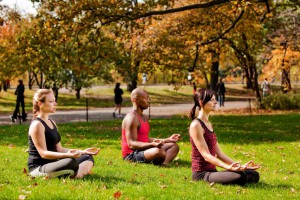 Meditation
Meditation
The stress in our lives may manifest physically, mentally, and emotionally, but it’s ultimately the massive amount of worrying and thinking that produces the problem. When someone meditates correctly, they are carefully forcing themselves to relax by thinking about…nothing! But, how do you think about nothing?
If you first start out it could take some practice, but once you get the hang of it meditation feels really good. Simply thinking about the word “nothing”, focusing on your breathing, or focusing on the darkness of closed eyes can help, especially when first starting out. Thinking about nothing will help to decrease stress, ultimately leading to what sufferers of Adrenal Fatigue hope, is a natural balance between up and down.
Hundreds of studies have been completed on the idea of being “mindful”, a term used to describe the practice of meditation. Within those studies there have been many similar findings, including, the increase in the balancing of hormones. In fact, it has been corroborated between studies and those who practice meditation regularly, that the increase of cortisol and epinephrine, recreates the “runners high” sensation.
All from thinking about nothing and there’s more good news. Meditation has also been shown to decrease heart rate and blood pressure consistently within individuals who use meditation daily. But there are more benefits:
Physical Benefits
- Meditation enhances cognitive performance by strengthening communication between various areas of the brain.
- It lowers cortisol levels in the body and thus decreases stress.
- It lowers the heart rate and respiratory rate and helps to lower high blood pressure.
- Improved breathing helps oxygenate the body more efficiently.
- Reduces muscular tension as well as associated aches and pains.
Psychological Benefits
- Mental stress and pressure is often mentioned as a cause of a high percentage of physical diseases that are prevalent in the world today, such as cancer. The relaxing effects created by meditating can greatly help combat stress and its effects.
- Heightened sense of wellbeing and happiness.
- Helps to develop a positive attitude and optimistic outlook.
- Helps to heighten self-confidence and self- esteem.
- Helps to focus better and improve concentration.
Lifestyle Benefits
- Better interpersonal relationships.
- Able to be more in tune with your own needs.
- Increased productivity through increased ability to focus.
- Increased tolerance, compassion and empathy for others.
- Deep introspection increases knowledge and acceptance of the self.
These are just some of the benefits that you can experience by including meditation as a part of your regular daily routine.
How To Get Started?
Meditation and being mindful is about awareness, understanding your surroundings, and not allowing thoughts to dictate your next thought, or action.
Simply put, learning not to engage with every thought that comes into your mind. So, as mentioned earlier, you can begin by focusing on certain words, like “nothing”, on your breath, or the darkness of closed eyes to relieve as much of the feeling of racing thoughts, but there are other things that may be a bit easier.
Below, there is a list of things that can be done to help you in your journey to being less stressed and more mindful. Don’t expect it to work the first time, you’re new to this. Changing the way you think and react is very difficult. But, it is possible to learn how to be mindful, allowing yourself to live with less stress, and ultimately handle hard and difficult situations and choices better.
You do not need to use all of these meditation options. However, you should attempt a few to see which ones fit your lifestyle and personality best. Good luck!
- Guided Visualization is not the most commonly used in America, but it is well known. It is the practice of focusing on specific objects, images, or imaginary places. Use pleasant thoughts of course. Slow breathing is the goal. This really should be done from a still position. Standing or sitting is fine, however if you begin moving about, chances are you will begin losing focus on the image.
- Kundalini Meditation focuses on self awareness. This practice of meditation focuses on breathing. However, the main focus is on what is called, “upward breathing”. That’s a metaspiritual way of saying, inhaling. This could be done from any position, though sitting is preferred.
- Vipassana Meditation is the most popular within the western world. This form of meditation focuses on breathing. This will help you to learn how to let thoughts come and go as they please without dwelling on any one in particular. Attempt focusing on the sound of your breathing. This can be done in any position, though it’s most commonly done in a sitting position, while in a quiet room.
Another highly popular form of meditation is Transcendental Meditation and this type of meditation focuses on the repitition of a mantra (word). Any word can be used and the meditation can be done anywhere, anytime. It is often advised to practise the meditation twice on a daily basis for 20 minutes. The technique is very straight forward:
- Make sure you are sitting or laying in a comfortable position
- Close your eyes, wait for 2 minutes and think about the mantra
- At the end of the meditation stop thinking about the mantra, wait for two minutes and then open your eyes
Some pointers:
In this meditation, you do not concentrate, you do not try to say the mantra clearly. Mental repetition is not a clear pronunciation, it is just a faint idea.
Also don’t try to make a rhythm of the mantra or to control your thoughts. If a thought comes, you do not try to push it out. When you become aware that you are not thinking the mantra, then you quietly come back to the mantra.
The mantra may change in different ways. It can get faster or slower, louder or softer, clearer or fainter. Its pronunciation may change, lengthen or shorten or even may appear to be distorted or it may not appear to change at all. In every case, just take it as it comes, neither anticipating nor resisting change, just simple innocence.

Other Forms Of Meditation
There are many other types of meditation, including: Zazen, Qi Gong, Hypnosis Meditation and Heart Rhythm Meditation. Each type of meditation offers similar results such as relaxation and increased mindfulness.
Look into these practices if you are interested. Rest assured that anyone can meditate, you don’t need any special abilities to do so and there are no strict rules as far as the details go, the key is that whatever works for you is right. Meditation WILL aid in decreasing Adrenal Fatigue, and can help to keep you physically healthy for a good long time. Try it, the only thing you have to lose is stress.
Don’t know how or where to start or maybe you don’t have the time for a 20-minute meditation? Here is our favorite book on Meditating in 2 Minutes!



 Meditation
Meditation






